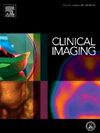评估用于区分不同类型卵巢肿瘤的 O-RADS 评分系统:使用非 DCE-MRI 的改良方法
IF 1.8
4区 医学
Q3 RADIOLOGY, NUCLEAR MEDICINE & MEDICAL IMAGING
引用次数: 0
摘要
目的 O-RADS MRI评分根据T1加权、T2加权和动态对比增强(DCE)图像的特征对附件肿块的风险进行分层。我们探索了一种改良方法,以评估将 DWI/ADC 与非 DCE-MRI 纳入 ORADS 评分系统的价值,并评估在区分不同类型卵巢肿瘤方面的诊断性能和读片者之间的一致性。方法这项回顾性研究纳入了 2017 年 1 月至 2021 年 12 月期间接受盆腔 MRI 检查的 218 名女性,其中有 221 例卵巢肿瘤。两名放射科医生使用原始和修改后的 O-RADS 方法(将 DWI/ADC 与非 DCE 结合在一起)对每个病灶进行独立评估。结果原始方案的 ROC 曲线下面积(AUC)在所有病变中为 0.945,在上皮细胞、生殖细胞和性索间质肿瘤中分别为 0.947、0.992 和 0.758。改良方法对所有病变的 AUC 值为 0.959,对三个类别的 AUC 值分别为 0.962、0.997 和 0.837。在原始方案中,读片者之间对所有病变的一致性为 "优",对亚组的一致性为 "良",而在改良方案中,读片者之间对所有类别的一致性提高到了 "优"。它进一步提高了亚组解释的一致性。改进后的方法可作为一种有效的诊断工具,无需使用 DCE,从而进一步促进其在基层医院的应用。本文章由计算机程序翻译,如有差异,请以英文原文为准。
Assessment of the O-RADS scoring system for the differentiation of different types of ovarian neoplasms: A modified approach with non-DCE-MRI
Purpose
The O-RADS MRI score stratifies adnexal mass risk with characteristics of T1-weighted, T2-weighed and dynamic contrast-enhanced (DCE) images. We explored a modified approach to evaluate the value of incorporation DWI/ADC with non-DCE-MRI in ORADS scoring system, and to assess the diagnostic performance and interreader consistency in differentiating ovarian neoplasm with different types.
Methods
This retrospective study included 218 women who underwent pelvic MRI with 221 ovarian tumors between January 2017 and December 2021. Two radiologists independently assessed each lesion using the original and modified O-RADS approach (incorporating DWI/ADC with non-DCE). Cohen's weighted-kappa and ROC analyses were employed to assess interreader consistency and diagnostic efficiency across all lesions and three ovarian neoplasms categories.
Results
The area under the ROC curve (AUC) of the original protocol was 0.945 for all lesions and 0.947, 0.992, and 0.758 for the epithelial cell, germ cell and sex cord-stromal neoplasms. The modified approach achieved AUCs of 0.959 for all lesions and 0.962, 0.997, and 0.837 for the three categories. The interreader agreement was ‘excellent’ for all lesions and ‘good’ for the subgroups with the original protocol, improving to ‘excellent’ for all categories with the modified approach.
Conclusion
A modified O-RADS incorporating DWI/ADC with non-DCE MRI yields high diagnostic performance in differentiation of different types of ovarian neoplasms. It further improves consistency in subgroup interpretation. The modified approach can serve as an effective diagnostic tool without DCE, further promoting its adoption in primary hospitals.
求助全文
通过发布文献求助,成功后即可免费获取论文全文。
去求助
来源期刊

Clinical Imaging
医学-核医学
CiteScore
4.60
自引率
0.00%
发文量
265
审稿时长
35 days
期刊介绍:
The mission of Clinical Imaging is to publish, in a timely manner, the very best radiology research from the United States and around the world with special attention to the impact of medical imaging on patient care. The journal''s publications cover all imaging modalities, radiology issues related to patients, policy and practice improvements, and clinically-oriented imaging physics and informatics. The journal is a valuable resource for practicing radiologists, radiologists-in-training and other clinicians with an interest in imaging. Papers are carefully peer-reviewed and selected by our experienced subject editors who are leading experts spanning the range of imaging sub-specialties, which include:
-Body Imaging-
Breast Imaging-
Cardiothoracic Imaging-
Imaging Physics and Informatics-
Molecular Imaging and Nuclear Medicine-
Musculoskeletal and Emergency Imaging-
Neuroradiology-
Practice, Policy & Education-
Pediatric Imaging-
Vascular and Interventional Radiology
 求助内容:
求助内容: 应助结果提醒方式:
应助结果提醒方式:


